
Методичка №140
.pdf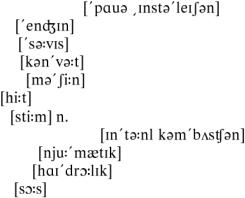
НТТС (IV семестр)
POWER INSTALLATIONS OFCONSTRUCTION MACHINERY
A power installation is a complex consisting of an engine and its servicing systems. It converts some kind of energy into mechanical work. Engines are machines which change heat into motion. Depending on the type of engine, power installations employed in presentday construction machinery,intractorsandtruckscanbesubdividedintothefollowinggroups: steam, internalcombustion, electric, pneumatic and hydraulic ones.
Steam engines and internalcombustion engines are prime movers. They transform energy taken from fuel into mechanical work. Electric, pneumatic and hydraulic engines are known as secondary movers. They convert into mechanical work the energy produced by generators.
Internal combustion engines are the principal power installations employedinmobileandselfpropelledconstructionmachineryaswellasin trucks and tractors. They are very efficient under all working conditions and do not depend on the external sources of energy.
Electric power installations incorporate generators transforming mechanicalenergyintoelectricalone.Thelatteristhenusedtodriveelectric motors.
Thewidespreaduseofelectricdrivesinroadmakingandconstruction machinesisduetotheirconsiderableeconomicalandoperationaladvantages as compared to other types of drives.
Pneumaticandhydraulicpowerinstallationsareemployedformachine control systems, auxiliary devices and mechanical tools.
Vocabulary: |
|
|
power installation |
– силовая установка |
|
engine |
n. – двигатель |
|
servicе |
v.– обслуживать |
|
convert |
v.– превращать |
|
machine |
n. – машина, механизм |
|
heat |
n. – теплота |
|
steam |
– пар |
– внутреннее сгорание |
internalcombustion |
||
pneumatic |
a.– пневматический |
|
hydraulic |
a. –гидравлический |
|
source |
n. – источник |
|
generator 
 n.– генератор, источник энергии auxiliary
n.– генератор, источник энергии auxiliary 
 a. – вспомогательный
a. – вспомогательный
Answer the following questions:
1.What is a power installation?
2.What is the main function of a power installation?
3.What groups of power installations are there?
4.Why are steam engines and internal-combustion engines called prime movers?
5.How do the secondary movers work?
6.Why are internal-combustion engines the principal power installations in modern construction machinery?
7.What is the widespread use of electric drives in road making and construction machines due to?
8.What are pneumatic and hydraulic power installations employed for?
38 |
39 |
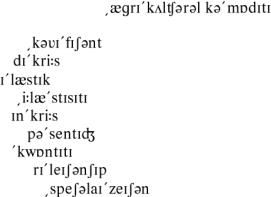
Э, М, ИНН, ПО (II семестр)
PRICE ELASTICITYOFDEMANDAND SUPPLY
Thereisarelationshipbetweendemandandprice.Howmuchdemand foracommodityisaffectedbyachangeinpriceiscalledelasticityofdemand. If a small change of price results in a large change in demand, the demand is called elastic, if the demand changes only a little, it is called inelastic. The price elasticity of demand coefficient is negative as demand usually falls with a rise in price.
The price elasticity of supply shows the percentage change in the quantity supplied resulting from a one-percent change in price.
Asanincreaseinthequantitysuppliedisnormallyaresultofarisein price, the coefficient is usually positive. We have a “0” (zero) elasticity whenapricechangeresultsinnoquantitysuppliedchange.Thisiscalleda perfectly inelastic supply. Provided the elasticities vary between zero and one, the supply is called inelastic. With coefficients greater than one, the supplyiscalledelastic.Thepercentagechangeinquantityislargerthanthe corresponding percentage change in price.
Agriculturalsupplyismostlyinelasticbecause ofthe highproportion of such inputs as land, buildings, and machinery. The elasticities of agricultural commodities (potatoes, wheat, fruits, eggs, milk) vary greatly. Becauseofincreasingspecializationofproduction,offarmanimalproducts, in particular, elasticities for such commodities as pigs or broilers have decreased in recent years.
Vocabulary: |
|
|
agricultural commodity [ |
] – сельскохозяй- |
|
ственный товар |
|
|
coefficient [ |
] n. – коэффициент |
|
decrease [ |
] v. – уменьшать(ся), снижать(ся) |
|
elastic [ |
] a. – эластичный |
|
elasticity [ |
] n. – эластичность |
|
increase [ |
] v. – увеличивать(ся) |
|
percentage [ |
] n. – процент |
|
quantity [ |
] n. – количество |
|
relationship [ |
] n. – отношение, взаимоотношение, связь |
|
specialization [ |
] n. – специализация |
|
vary [ ] v. – меняться, изменяться, варьироваться wheat [
] v. – меняться, изменяться, варьироваться wheat [ ] n. – пшеница
] n. – пшеница
Answer the following questions:
1.Which demand is called elastic?
2.What units is elasticity of supply shown in?
3.Why is the price elasticity of demand coefficient negative and the corresponding coefficient for supply positive?
4.What supply is called inelastic?
5.What is the difference between the inelastic and the perfectly inelastic supply?
6.Why is agricultural supply usually inelastic?
7.What is the tendency of agricultural supply development?
40 |
41 |
Э, М, ИНН, ПО (III семестр)
FISCALPOLICY
Fiscal policy is an instrument of demand management which is used toinfluencethelevelofeconomicactivityinaneconomythroughthecontrol of taxation and government expenditure.
The government can use a number of taxation measures to control aggregate demand or spending: direct taxes on individuals (income tax) and companies (corporation tax) can be increased if spending has to be reduced. Spending can also be reduced by increasing indirect taxes: an increase in the VAT on all products or excise duties on particular products will result in lower purchasing power.
The government can change its own expenditure to affect spending levels as well: a cut in purchases of products or capital investment by the
government can reduce total spending in the economy.
If the government is to increase spending, it creates a budget deficit, reducing taxation and increasing its expenditure.
A decrease in government spending or an increase in taxes reduces aggregatedemandtoavoidinflation.Bycontrast,anincreaseingovernment spending and/or decrease in taxes – an injection into the circular flow of national income–stimulatesaggregate demandandcreatesadditionaljobs to avoid unemployment.
Inpractice,however,theeffectivenessoffiscalpolicycanbereduced by a number of problems. Taxation rate changes, particularly changes in income tax, take time to make. Considerable proportion of government expenditure on, for example, schools, hospitals and defense cannot easily be changed without lengthy political lobbying.
Vocabulary:
aggregate demand [


 ] – совокупный спрос avoid [
] – совокупный спрос avoid [ ] v. – избегать
] v. – избегать
budget deficit [
 ] – бюджетный дефицит corporation tax [
] – бюджетный дефицит corporation tax [

 ] – корпоративный налог create [
] – корпоративный налог create [ ] v. – создавать
] v. – создавать
expenditure [ ] n. – расходы
] n. – расходы
fiscal policy [

 ] – налоговая политика influence [
] – налоговая политика influence [ ] v. – оказывать влияние injection [
] v. – оказывать влияние injection [

 ] n. – вливание
] n. – вливание
lengthy [ ] a. – длительный, продолжительный measure [
] a. – длительный, продолжительный measure [ ] n. – мера, система мер
] n. – мера, система мер
purchasing power [



 ] – покупательная способность
] – покупательная способность
Answer the following questions:
1.What is the effect of reduced aggregate demand in an economy?
2.How can aggregate demand be reduced?
3.What is the effect of higher aggregate demand?
4.How can aggregate demand be increased?
5.What can decrease the effectiveness of fiscal policy?
42 |
43 |
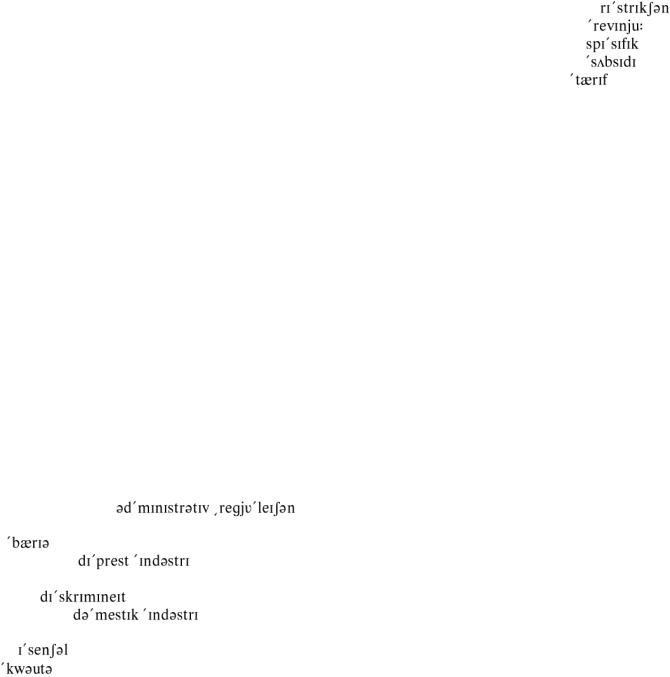
Э, М, ИНН, ПО (IVсеместр)
FOREIGN TRADE
Foreign trade is an essential part of a nation’s economy but governmental restrictions are sometimes necessary to protect national interests. Govern-ment actions may occur in response to the trade policies of other countries or in order to protect specific depressed industries.
One method of limiting imports is simply to close the channels of entryintoa country. Usuallymaximumallowable import quantitiesknown as quotas may be set for specific products. Quotas serve as the quickest meansofstoppingorevenreversinganegativetrendinacountry’sbalance of payments as well as of protecting domestic industry from foreign competition.
Another common way of restricting imports is by imposing tariffs or taxesonimportedgoods.Atariffpaidbythebuyerofthe importedproduct makes the price higher for that good in the importing country. The higher pricereducesconsumerdemand,effectivelyrestrictingtheimport.Thetaxes collected on the imported goods also increase revenues for the nation’s government. Tariffs also serve as a subsidy to domestic producers of the goods taxed.
In recent years the use of non-tariff barriers to trade has increased. It may result in some administrative regulations that discriminate against foreign goods and in favour of domestic ones. Direct government support of depressed domestic industries is considered as a non-tariff barrier to trade,assuchsupportputstheaidedindustriesatanunfairadvantageamong trading nations.
Vocabulary: |
|
] – администр- |
administrative regulation [ |
||
ативное регулирование |
|
|
barrier [ |
] n. – препятствие, преграда |
|
depressed industry [ |
] – отрасль промышленности, |
|
переживающая спад (кризис) |
||
discriminate [ |
|
] v. – ущемлять |
domestic industry [ |
] – отечественная промышлен- |
|
ность |
] a. – обязательный, существенный, необходимый |
|
essential [ |
||
quota [ |
] n. – квота, лимит |
|
restriction [ |
] n. – ограничение |
revenue [ |
] n. – доход |
specific [ |
] a. – определенный, конкретный |
subsidy [ |
] n. – субсидирование |
tariff [ |
] n. – тариф, расценка |
Answer the following questions:
1.Why are governmental restrictions of foreign trade sometimes necessary?
2.What do quotas provide?
3.How do tariffs or taxes on imported goods work?
4.What is considered as a non-tariff barrier to trade?
5.How does it work?
44 |
45 |
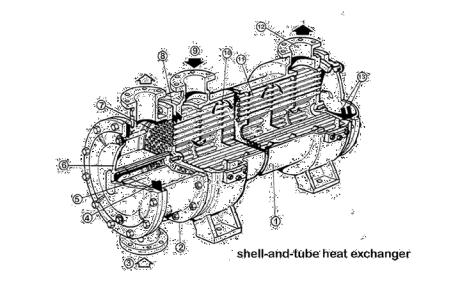
ТЭ, ЭЭ, ТСБ, ПВ (II семестр)
HEATEXCHANGERS
The construction of most heat exchangers falls into one of two categories: shell and tube or plate. Each type has its advantages and disadvantages.Themostbasicandthemostcommontypeofheatexchanger construction is shell and tube heat exchanger (Figure 1.). This type of heat exchanger consists of a set of tubes in a container called a shell. The fluid flowing inside the tubes is called the tube side fluid and the fluid flowing on the outside of the tubes is the shell side fluid. At the ends of the tubes, thetubesidefluidisseparatedfromtheshellsidefluidbythetubesheet(s). Thetubesarerolledandpress-fittedorweldedintothetubesheettoprovide a leak tight seal.
Platetypeheatexchanger(Figure2.)consistsofplatesinsteadoftubes toseparatethehotandcoldfluids.Thehotandcoldfluidsalternatebetween each of the plates. Baffles direct the flow of fluid between plates. Because each of the plates has a very large surface area, the plates provide each of the fluids with an extremely large heat transfer area.Therefore a plate type heatexchangeriscapableoftransferringmuchmoreheat.Thisisduetothe larger area the plates provide over tubes. Due to the high heat transfer efficiency of the plates, plate type heat exchangers are usually very small. Becauseofthisproblem,platetypeheatexchangershaveonlybeenusedin small,lowpressureapplicationssuchasonoilcoolersforengines.However, newimprovementsingasketdesignandoverallheatexchangerdesignhave allowed some large scale applications of the plate type heat exchanger.As older facilities are upgraded or newly designed facilities are built, large platetypeheatexchangersarereplacingtubeandshellheatexchangersand becomingmore common.
Figure 1. Shell and tube heat exchanger.
1.shell (cylindrical,
2.header, water box
3.cooling fluid
4.cover seal
5.separation plate (for 2-pass arrangement)
6.header cover
7.tube plate
8.gaskets (between tube plate and shell, tube plate and header)
9.hot fluid, (to be cooled)
10.baffle (to direct the flow of hot fluid back and forth across the tube bundle)
11.tube bundle, tube nest, tube stack
12.shell branches
13.elastomer seals (on both sides of a safety leakage ring)
46 |
47 |
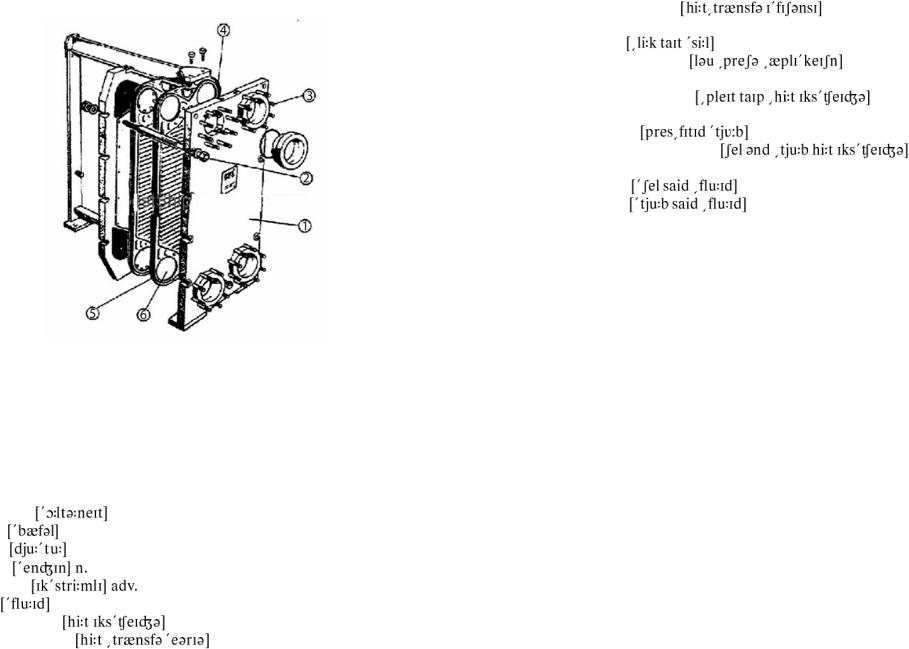
Figure 2. Plate type heat exchanger.
1.end plate, head plate, clamping plate
2.tie-bolt
3.fluid branches, fluid connections (in line with ports in the plates)
4.stack of exchange plates (with dimples pressed in the plate surface)
5.peripheric  elastomer seal (периферическое tie-bolt
elastomer seal (периферическое tie-bolt
уплотнение из эластомера)
6.ports and seals
Vocabulary: |
|
|
|
alternate – |
|
|
v. – поочередно сменяться |
baffle |
|
n. – перегородка |
|
due to |
|
prep. – благодаря/вследствие |
|
engine |
|
|
– двигательная установка |
extremely |
|
|
– крайне/чрезвычайно |
fluid |
n.– текучая среда |
||
heat exchanger |
|
– теплообменник; |
|
heat transfer area |
– поверхность теплообмена / |
||
теплопередачи |
|
|
|
heat transfer efficiency |
– коэффициент тепло- |
передачи |
|
leak tight seal |
– непроницаемая перемычка/прокладка |
low pressure application |
– установка, |
работающая под низким давлением |
|
plate type heat exchanger |
– пластинчатый |
теплообменник |
|
press-fitted tube |
– запрессованная труба |
shell and tube heat exchanger |
– кожух- |
отрубный теплообменник |
|
shell side fluid |
– межтрубная текучая среда |
tube side fluid |
– внутритрубная текучая среда |
Answer the following questions:
1.What two main types of constructions are mentioned in the text?
2.What does shell and tube heat exchanger consist of?
3.What does plate type heat exchanger consist of?
4.What is the advantage of plate type heat exchanger?
5.Why is plate type heat exchanger capable of transferring much more heat?
6.Why is plate type heat exchanger used in small, low pressure applications only?
7.What type of heat exchanger is becoming more common?
48 |
49 |
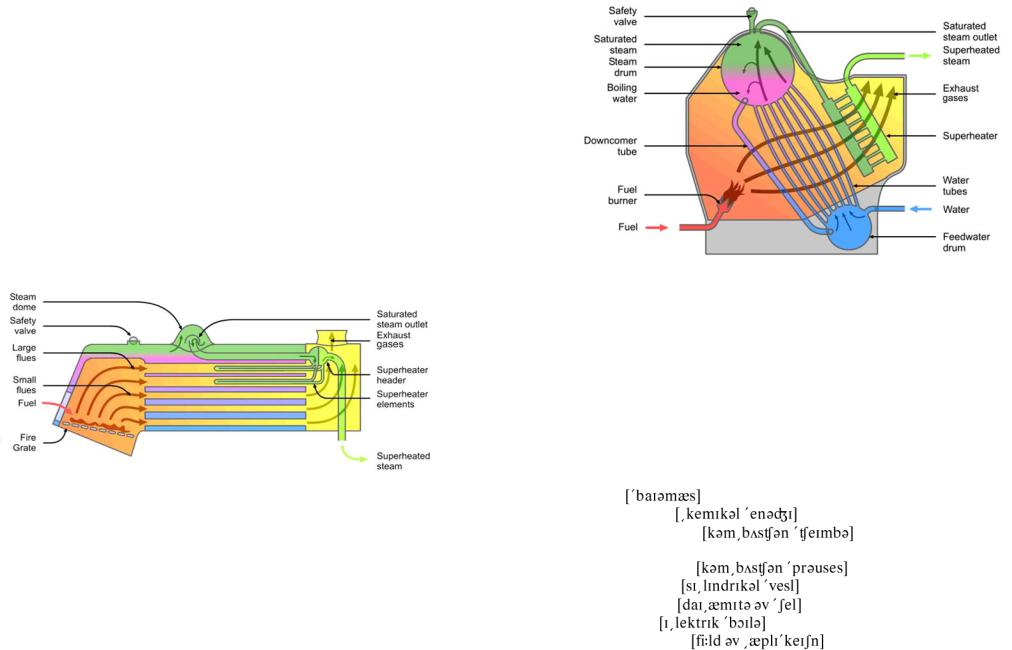
ТЭ, ЭЭ, ТСБ, ПВ (III семестр)
BOILERS
Boilerscanbeclassifiedinvariousways,dependingonfiringmethod used, fuel fired, field of application, type of water circulation employed, andpressureofsteam.Dependingontheirconstructionboilerscanbedivided into: fire tube boilers (Figure 3), water tube boilers (Figure 4).
Fire tube boilers have been used in various early forms to produce steam for industrial purposes. The fire tube boiler is a special form of the shell tube type boiler. A shell type boiler is a closed, usually cylindrical vesselthatcontainswater.Hotgasespassthroughthetubes duringthe heat transfer process. The shell boiler evolved into modern forms such as the electric boiler, in which heat is supplied by electrodes embedded in the water.
Figure 3. Fire tube boilers.
The difference between fire tubes and water tubes is simple; water flows through water tubes instead of fire. The advantage of the water tube boileristhatitcanworkinhighsteampressure andcapacities.Withhigher steam pressure and capacities, fire tube boilers would need large diameter of shell. With such large diameter, the shell would have to operate under suchextremepressure andthermalstressesthattheirthickness would have been too large.
Figure 4. Water tube boilers.
The basic purpose of any boiler is to convert the chemical energy in fuel into thermal energy that can be used to generate steam or hot water. Inside the combustion chamber, two fundamental processes must occur to achieve this objective.First,the fuelmust be mixedwith sufficientoxygen toallowsustainedcombustion.Theheatedgasesproducedbythecombustion process must then transfer the thermal energy to a fluid such as water or steam.The designofthe boilersdependsonfactors suchasthe type of fuel andthemethodselectedtotransferthermalenergy.Boilersaremanufactured in a wide range of sizes to burn coal, oil, natural gas, biomass as well as other fuels and fuel combinations.
Vocabulary: |
|
biomass |
– биомасса; |
chemical energy |
– химическая энергия; |
combustion chamber |
chamber – камера |
сгорания; |
|
combustion process |
– процесс горения; |
cylindrical vessel |
– цилиндрический сосуд; |
diameter of shell |
– диаметр кожуха |
electric boiler |
– электрический бойлер |
field of application |
– область применения |
50 |
51 |
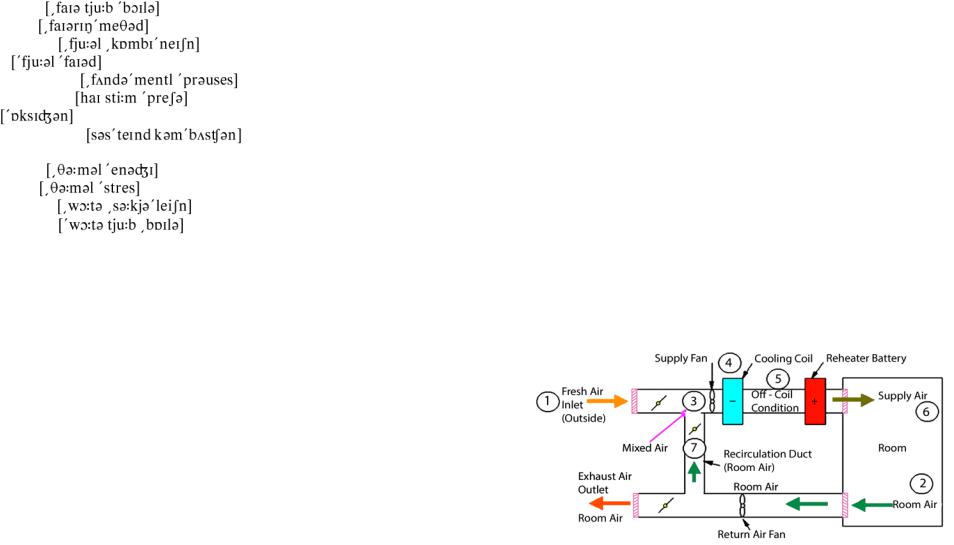
fire tube boiler |
|
– дымогарный котел |
firing method |
|
– способ/метод горения |
fuel combination |
|
– горючая/топливная смесь |
fuel fired |
|
– работающий на минеральном топливе |
fundamental process |
|
– основной процесс |
high steam pressure |
|
– высокое давление пара; |
oxygen |
n.– кислород; |
|
sustained combustion |
– устойчивое / равно- |
|
мерное горение |
|
|
thermal energy |
|
– термическая энергия |
thermal stress |
|
– термическое напряжение |
water circulation |
|
– циркуляция воды; |
water tube boiler |
|
– водотрубный котел |
Answer the following questions:
1.How can boilers be classified?
2.How can boilers be divided depending on their construction?
3.What have fire tube boilers been used for?
4.What is the difference between fire tubes and water tubes?
5.What is the advantage of the water tube boiler?
6.What is the basic purpose of any boiler?
7.Whattwofundamentalprocessesmustoccurtoachievethisobjective?
8.What does the design of the boilers depend on?
9.How are boilers manufactured?
ТЭ, ЭЭ, ТСБ, ПВ (IVсеместр)
AIR-CONDITIONING
Anair-conditioningcyclecomprisesseveralair-conditioningprocesses thatareconnectedinasequentialorder.Theworkingsubstancetocondition air may be chilled or hot water, refrigerant, desiccant, etc.
Air-conditioning cycles can be grouped into two categories: 1. Open cycle, in which the moist air at its end state does not resume its original state. An air conditioning cycle with all outdoor air is an open cycle. 2.Closedcycle,inwhichmoistairresumesitsoriginalstateatitsendstate. Air-conditioning cycle that conditions the mixture of recirculating and outdoor air,suppliesit; recirculates part of thereturnair,andmixes itagain with outdoor air is a closed cycle.
Abasic air-conditioningsystem is a packaged system of supplyair at a constant volume flow rate, serving a single zone, equipped with only a single supply/return duct.
Figure 5. Abasic air-conditioning schematic for summer mode.
Here,returnairfromtheconditionedspace(2)mixeswithrequiredamount of outdoor air (1) at point (3) for acceptable indoor air quality and energy saving. The mixture is then cooled and dehumidified to (Apparatus Dew Point)ADP(4)atthecoolingcoil.Theactualoff-coilconditionisrepresented
(5) due to inefficiency (bypass) of cooling coil. The conditioned air is suppliedtotheroomthroughthesupplyfan,supplyduct,andceilingdiffuser
(6). Supply air then absorbs the sensible and latent load from the space,
52 |
53 |
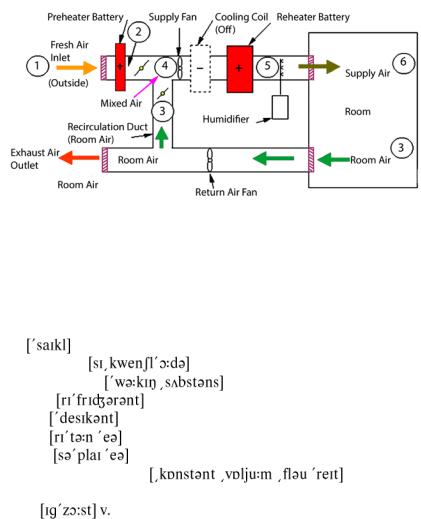
becoming the space air (2). Room air is returned back to the cooling unit againandformsaclosedcycle.Partofthereturnairisexhaustedtobalance the outdoor air intake and infiltration.
Figure 6.The psychrometric diagrambelowshows a typical wintercycle.
An air-conditioning system has to handle a large variety of energy
inputsandoutputsinandoutofthebuildingwhereitisused.Theefficiency of the system is essential to maintain proper energy balance. The system will operate properly if well maintained and operated.
Vocabulary: |
|
|
|
cycle |
n. – цикл; |
|
|
sequential order |
– последовательный порядок; |
||
working substance |
– рабочая среда; |
|
|
refrigerant |
|
n. – холодильная установка; |
|
desiccant |
|
n. – поглотитель влаги/осушитель; |
|
return air |
|
– отработанный/рециркулирующий воздух; |
|
supply air |
|
– поступающий/подаваемый воздух; |
|
constant volume flow rate |
– постоянная |
||
величина скорости потока; |
|
||
exhaust |
|
– выпускать/разрежать. |
|
Answer the following questions:
1.What working substance do you know ?
2.What can air-conditioning cycles be grouped into?
3.What cycle is called a closed cycle?
4.What is a basic air-conditioning system?
5.What does an air-conditioning cycle comprise?
6.How does a basic air-conditioning system work?
7.How is the conditioned air supplied to the room?
8.What forms a closed cycle?
9.Why is part of the return air exhausted?
10.What does an air conditioning system have to handle?
11.Why is the efficiency of the system essential?
12.In what case will the system operate properly?
54 |
55 |
Оглавление |
|
ABOUTMYSELFANDMYSTUDY...................................................................... |
3 |
BUILDINGMATERIALS......................................................................................... |
6 |
SHEARWALLANDFRAMESYSTEMS................................................................. |
8 |
BOULTONHOUSE,CAMBRIDGE,ENGLAND................................................. |
10 |
SAINTPETERSBURG.............................................................................................. |
13 |
URBANDESIGN...................................................................................................... |
17 |
ECO-ARCHITECTURE .......................................................................................... |
19 |
COMPUTERSYSTEMS........................................................................................... |
21 |
THEWIDEWORLDWEB........................................................................................ |
23 |
COMPUTERSOFTWAREANDHARDWARE .................................................... |
26 |
INTERNALCOMBUSTIONENGINE .................................................................. |
28 |
AUTOMOBILESAFETY........................................................................................ |
30 |
HYBRIDCARS......................................................................................................... |
32 |
CRANES..................................................................................................................... |
34 |
EXCAVATORS ....................................................................................................... |
36 |
POWERINSTALLATIONSOFCONSTRUCTIONMACHINERY........................ |
38 |
PRICEELASTICITYOFDEMANDANDSUPPLY............................................... |
40 |
FISCALPOLICY...................................................................................................... |
42 |
FOREIGNTRADE................................................................................................... |
44 |
HEATEXCHANGERS ............................................................................................ |
46 |
BOILERS .................................................................................................................. |
50 |
AIRCONDITIONING ............................................................................................ |
53 |
АНГЛИЙСКИЙЯЗЫК
Учебно-методическое пособие №140
Разговорныетемы
Составители: ГлебовскийАлександрСергеевич, ДаниловаЛюдмилаРафкатовна, ДубовскаяНаталияЕвгеньевна, Лапшина Лилия Ярославовна, Потапчук Аурика Витальевна,
СарянМаринаАрташевна
Компьютерная версткаИ. А. Яблоковой
Подписано кпечати 24.12.13.Формат 60×80 1/16.Бум. офсетная. Усл. печ. л. 3,3. Тираж 100 экз. Заказ 1. «С» 1.
Санкт-Петербургский государственный архитектурно-строительный университет. 190005, Санкт-Петербург, 2-я Красноармейскаяул., д. 4.
Отпечатано на ризографе. 190005, Санкт-Петербург,2-я Красноармейская ул., д. 5.
56
